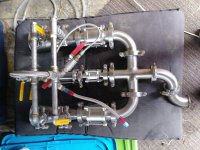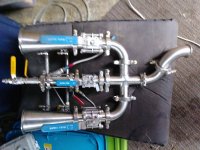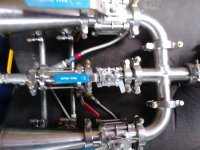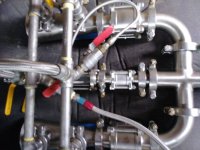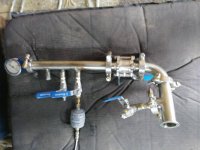Itsgotatail
Member
So I'm thinking about tearing apart my MKIII/IV hybrid and rebuild it into something better.
It's currently two 4"x48" material columns, a 12"x12" collection vessel, bi-flow system - I do one run up and another down, 20-30lb of gas. passed over 6-7lb of material (probably too much gas) It was built in late 2013 so a lot of new tech has been developed since then. Biggest problem is that it's all set up to run connected to this HUGE chassis/base. Like 6'x8'x4' without anything attached (nearly 10' tall assembled) and 800+ lbs, because there's a non-working HUGE AC unit welded to the frame. A LOT of work to cut it loose. It takes an engine hoist crane to get the thing off the ground. Lots of guys to get it in and out of a pickup. Not feasible anymore. Can't find a place to set it up anywhere anymore...
I can only manage two runs/day (~14lb starting material) if I'm there for 12 hours. Unfortunately my entire chilling system consists of my (100# standard yellow/white) recovery tank sitting in a 30gallon pot of standard ice surrounding it, and a regular ice surrounded SS coil (that 69-ish size; 6" diameter by 10" tall, ~10 coils) located between the recovery pump and the recovery tank. Also, the only heating being done is by a nice big 220v (another issue) 12"x30" silicone band heater, wrapped around a pot that the collection vessel sits in. I have to run 220v into this system - over a $100+ cord/socket JUST for that, because the AC unit chiller no longer works, which was originally chilling the recovery tank to 5°F. Now I just use ice.
I recognize that this is beyond insufficient, it's downright dangerous...
How did I get to the point where I have a $10k+ extractor (actually $25k+, in 2013, including a lot of expensive labor)
But can't afford $500-2500 in simple upgrades?
Truthfully, this whole rig was payment for an old debt. I just decided to keep it and pick up a new hobby instead of sell it. I've only done maybe 20 runs since I got it in Jan 2014. It's truly a hobby for me, that I haven't been able to afford to fund. Something that I tinker with 1-2 times/month. I haven't made a penny on it (nor do I intend to). But it is pretty sweet to just crank it up once every couple of months and be set for myself and all my friends turning trash into treasure.
So now, I have ~$2500 available for upgrades. First choice would be a CMEP-OL, but I'm going to save that for the next round. I want to be prepped for it, so I can truly appreciate the possible 2.5x increase in throughput. Here's my thoughts on what to do instead:
First, a simpler rack system - preferably something that fits inside my midsize camper. This would necessitate splitting the rigid structure and replacing a two inch column with a 1/2" flexible line between the material column and the collection spool...no problem. 8-10' tall is just too long to trust free-standing, but a set of 4' wide rigid columns, connected by flexible hoses are basically fine, just bungee corded to a backboard (J/K . Some reducers, hoses, etc. No biggie.
. Some reducers, hoses, etc. No biggie.
Then I was thinking about simplifying it from a dual column to a single column system. The dual columns seem like they actually slow me down. It's still twice as much butane that has to be recovered, which is most of the time involved. A lot of unnecessary plumbing. A lot of extra parts for later can be scrounged from here.
So I'm thinking about setting up my second 4"x48" column either before or after my material column. Either to prechill my butane before injection, or to work as a dewax chamber. I'd really like to be able to run live (from my freezer) material. In fact, I NEED that ability, with this set of upgrades.
Next, I have a whole secondary 12"x 12" collection spool, bottom, and a second top. I'm considering strapping the two spools together and laying it horizontal for more recovery surface area, like some of BHOgart's machines. Maybe I'll have to get new lids, maybe not. Obviously, I'm trying to reuse as many parts as possible.
But the big question is how do I incorporate the -10
to -40°F treatment into this system? And where? I'd like to not have to replace my material columns...they're not cheap, and the sleeved/jacketed replacements are quite a bit more. I've heard a little about blasting a small amount of butane in, then pulling back to freeze the column easier? If I can keep my second material column as a spare, for prepping the next round, and instead chill using different methods, that would be great. I really want to get to the point where one, or even a pair of CMEP-OLs wouldn't be able to keep up with the rest of the system. I know that might cost $5+k. That's like a 10-20L lab chiller...probably too small. I'll try for some pics tomorrow.
One idea that I'm just barely starting to explore is peltier elements to assist a dry ice/nenatured alcohol system. There's 500+W peltier elements available for <$50. Seems like a sub-$1000 2.5-10kW cooler could be made, although it may require dry ice or LN2 for the cold side. Anyone played with this? I know...so many questions! Maybe I'll make an introductory post tomorrow. This site has been my primary source of info on extraction for 4+ years now!
It's currently two 4"x48" material columns, a 12"x12" collection vessel, bi-flow system - I do one run up and another down, 20-30lb of gas. passed over 6-7lb of material (probably too much gas) It was built in late 2013 so a lot of new tech has been developed since then. Biggest problem is that it's all set up to run connected to this HUGE chassis/base. Like 6'x8'x4' without anything attached (nearly 10' tall assembled) and 800+ lbs, because there's a non-working HUGE AC unit welded to the frame. A LOT of work to cut it loose. It takes an engine hoist crane to get the thing off the ground. Lots of guys to get it in and out of a pickup. Not feasible anymore. Can't find a place to set it up anywhere anymore...
I can only manage two runs/day (~14lb starting material) if I'm there for 12 hours. Unfortunately my entire chilling system consists of my (100# standard yellow/white) recovery tank sitting in a 30gallon pot of standard ice surrounding it, and a regular ice surrounded SS coil (that 69-ish size; 6" diameter by 10" tall, ~10 coils) located between the recovery pump and the recovery tank. Also, the only heating being done is by a nice big 220v (another issue) 12"x30" silicone band heater, wrapped around a pot that the collection vessel sits in. I have to run 220v into this system - over a $100+ cord/socket JUST for that, because the AC unit chiller no longer works, which was originally chilling the recovery tank to 5°F. Now I just use ice.
I recognize that this is beyond insufficient, it's downright dangerous...
How did I get to the point where I have a $10k+ extractor (actually $25k+, in 2013, including a lot of expensive labor)
But can't afford $500-2500 in simple upgrades?
Truthfully, this whole rig was payment for an old debt. I just decided to keep it and pick up a new hobby instead of sell it. I've only done maybe 20 runs since I got it in Jan 2014. It's truly a hobby for me, that I haven't been able to afford to fund. Something that I tinker with 1-2 times/month. I haven't made a penny on it (nor do I intend to). But it is pretty sweet to just crank it up once every couple of months and be set for myself and all my friends turning trash into treasure.
So now, I have ~$2500 available for upgrades. First choice would be a CMEP-OL, but I'm going to save that for the next round. I want to be prepped for it, so I can truly appreciate the possible 2.5x increase in throughput. Here's my thoughts on what to do instead:
First, a simpler rack system - preferably something that fits inside my midsize camper. This would necessitate splitting the rigid structure and replacing a two inch column with a 1/2" flexible line between the material column and the collection spool...no problem. 8-10' tall is just too long to trust free-standing, but a set of 4' wide rigid columns, connected by flexible hoses are basically fine, just bungee corded to a backboard (J/K
Then I was thinking about simplifying it from a dual column to a single column system. The dual columns seem like they actually slow me down. It's still twice as much butane that has to be recovered, which is most of the time involved. A lot of unnecessary plumbing. A lot of extra parts for later can be scrounged from here.
So I'm thinking about setting up my second 4"x48" column either before or after my material column. Either to prechill my butane before injection, or to work as a dewax chamber. I'd really like to be able to run live (from my freezer) material. In fact, I NEED that ability, with this set of upgrades.
Next, I have a whole secondary 12"x 12" collection spool, bottom, and a second top. I'm considering strapping the two spools together and laying it horizontal for more recovery surface area, like some of BHOgart's machines. Maybe I'll have to get new lids, maybe not. Obviously, I'm trying to reuse as many parts as possible.
But the big question is how do I incorporate the -10
to -40°F treatment into this system? And where? I'd like to not have to replace my material columns...they're not cheap, and the sleeved/jacketed replacements are quite a bit more. I've heard a little about blasting a small amount of butane in, then pulling back to freeze the column easier? If I can keep my second material column as a spare, for prepping the next round, and instead chill using different methods, that would be great. I really want to get to the point where one, or even a pair of CMEP-OLs wouldn't be able to keep up with the rest of the system. I know that might cost $5+k. That's like a 10-20L lab chiller...probably too small. I'll try for some pics tomorrow.
One idea that I'm just barely starting to explore is peltier elements to assist a dry ice/nenatured alcohol system. There's 500+W peltier elements available for <$50. Seems like a sub-$1000 2.5-10kW cooler could be made, although it may require dry ice or LN2 for the cold side. Anyone played with this? I know...so many questions! Maybe I'll make an introductory post tomorrow. This site has been my primary source of info on extraction for 4+ years now!

